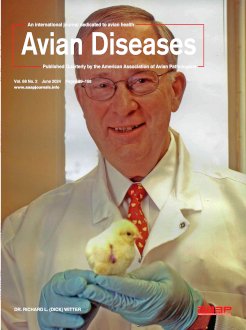The poultry-housing environment plays a significant role in the transmission and persistence of the egg-associated pathogen Salmonella Enteritidis in laying flocks. The commercial egg industry is in the midst of a transition toward cage-free housing, but the food safety ramifications of this shift are not yet certain. The present study assessed internal organ colonization by Salmonella Enteritidis in layer pullets reared in cage-free housing and infected at two different ages. Groups of 280 pullets were transferred from the rearing facility (at 9 wk of age in one trial and 15 wk in another) to a containment facility with four isolation rooms simulating commercial cage-free barns with perches and nest boxes (70 birds/room). Twenty-four pullets in each room were orally inoculated with Salmonella Enteritidis immediately after placement in the containment facility. At 1–2 wk postinoculation in each trial, samples of liver, spleen, and intestinal tract were collected from all birds in two rooms for bacteriologic culturing to detect Salmonella Enteritidis. At 21–22 wk of age, samples of spleen, ovary, and intestinal tract were similarly collected and tested from all birds in the remaining two rooms. Among samples collected at 1–2 wk postinoculation, Salmonella Enteritidis was isolated significantly more often from groups of pullets infected initially at 15 wk of age than from those infected at 9 wk (61% vs. 38% of livers, 59% vs. 31% of spleens, and 84% vs. 57% of intestines). Among samples collected at 21–22 wk of age, the frequency of recovery of Salmonella Enteritidis was again significantly greater in birds infected at 15 wk of age than in those infected at 9 wk (16% vs. 6% of spleens, 9% vs. 1% of ovaries, and 26% vs. 10% of intestines). These data suggest that Salmonella Enteritidis infections introduced into flocks during the later stages of pullet rearing have greater potential to persist into the early phase of egg production.
Nota de investigación- Colonización de órganos internos por Salmonella Enteritidis en pollitas de postura infectadas en dos edades diferentes durante la crianza en alojamiento sin jaulas.
El ambiente en alojamientos avícolas juega un papel importante en la transmisión y persistencia del patógeno asociado a los huevos Salmonella Enteritidis en parvadas postura. La industria comercial del huevo se encuentra en medio de una transición hacia alojamientos sin jaulas, pero las ramificaciones de este cambio en la seguridad alimentaria aún no están determinadas. El presente estudio evaluó la colonización de órganos internos por Salmonella Enteritidis en pollitas de postura criadas en alojamientos sin jaulas e infectadas a dos edades diferentes. Se transfirieron grupos de 280 pollitas desde las instalaciones de cría (a las 9 semanas de edad en un ensayo y a las 15 semanas en un segundo ensayo) a una instalación de contención con cuatro salas de aislamiento que simulaban alojamientos comerciales sin jaulas con perchas y nidos (70 aves/sala). Veinticuatro pollitas en cada sala fueron inoculadas oralmente con Salmonella Enteritidis inmediatamente después de su colocación en la instalación de contención. En cada ensayo, de una a dos semanas después de la inoculación, se recolectaron muestras de hígado, bazo y tracto intestinal para cultivo bacteriológico de todas las aves en dos salas para detectar Salmonella Enteritidis. A las 21-22 semanas de edad, se recolectaron y analizaron de manera similar muestras de bazo, ovario y tracto intestinal de todas las aves en las dos salas restantes. Entre las muestras recolectadas entre una y dos semanas después de la inoculación, Salmonella Enteritidis se aisló significativamente con mayor frecuencia en grupos de pollitas infectadas inicialmente a las 15 semanas de edad que en aquellas infectadas a las 9 semanas (61% contra 38 % en los hígados, 59% contra 31% de bazos y 84 % contra 57% en intestinos). Entre las muestras recolectadas a las 21-22 semanas de edad, la frecuencia de recuperación de Salmonella Enteritidis fue nuevamente significativamente mayor en aves infectadas a las 15 semanas de edad que en aquellas infectadas a las 9 semanas (16% contra 6% de bazos, 9% contra 1% en ovarios y 26% contra 10% de los intestinos). Estos datos sugieren que las infecciones por Salmonella Enteritidis introducidas en las parvadas durante las últimas etapas de la cría de pollitas tienen un mayor potencial para persistir en la fase inicial de la producción de huevos.





